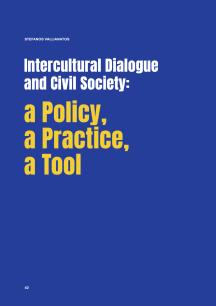Intercultural Dialogue and Civil Society: a Policy, a Practice, a Tool

The Mediterranean basin, historically, has been a crossroads of cultures and civilisations, as well as a theatre of operations and confrontation between major powers and empires. This has implied an interaction, be it of military, commercial, or human nature. From a different perspective, the Mediterranean Sea has also been perceived as a frontier, one that divides the Western (European) world from that of the Arab and Islamic one, whereas the nation-state framework has further exacerbated divisions between the societies in the region. With regard to the EU’s Eastern Neighbourhood, a political and ideological divide re-enforced a similar condition, notwithstanding cultural differences.
The rise of the EU’s prominence and the post-Cold war emerging framework, on the one hand, and the regional and domestic dynamics and developments in its Southern and Eastern Neighbourhood on the other, have established a new reality where the countries of the European Union re-emerged as the preferred migration destination from the Southern and Eastern Neighbourhood, and from the Mediterranean countries, including Sub-Saharan Africa and other parts of the Middle East and Eastern Asia. This could be attributed not only to the EU’s geographic proximity but also to its political and social charm; i.e., economic prosperity and well-developed institutions and practices of liberal democracy, including those of human rights. Meanwhile, the countries of the E.U., in order to maintain their high living standards, also due to their low birth rate and, therefore, ageing population, have been in dire need of ‘new blood’, provided by immigration, especially (yet not exclusively) by skilled youth. Meanwhile, the emerging expansion of the EU’s policies and interests, including globalisation per se, has immensely increased the interaction and relations between the EU and its neighbours, at all levels and domains, including the virtual space.
Hence, the co-existence with the ‘other’, i.e. the non-Western European in origin, does not take place any more only within the Western European societal fabric (the outcome of migration), but also in parallel to it, away and in the in between space: the implementation of exchange and co-executed programmes and activities, the attractiveness of the educational opportunities and studies that Western European institutions provide, but also in cyber space, as a community and a communication domain, all of this established an interaction different in nature and scope, and usually, a non-permanent presence within the E.U. of these populace.
Yet, such relationships, developed through traditional means (and other EU policy tools, like, initially the Euro-Arab Dialogue, the Mediterranean and the Renewed Mediterranean Policy, but also the Euro-Mediterranean Partnership10, although the latter did lay the foundations for a new focus), whose emphasis tended to be on the political, security, economic and commercial domain, proved insufficient to treat the new challenges that emerged and to build bridges that would allow a more sustainable and peaceful coexistence, based on an understanding of each other and accepting diversity as a creative force rather than an abnormality. Historically overburdened, Euro-Mediterranean rapprochement had to face new challenges and threats, including Islamophobia, anti-Semitism, and xenophobia in general, radicalisation, and other forms of extremism, as well as pressing human rights failures, poor democratic performance, etc. Against this backdrop, there was a need for a new approach that would complement the existing mechanisms and would be applied through culture and civil society.